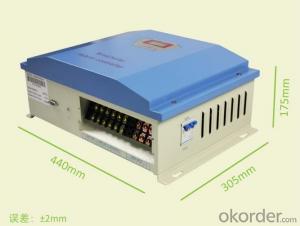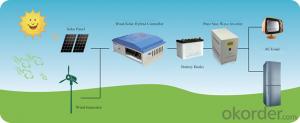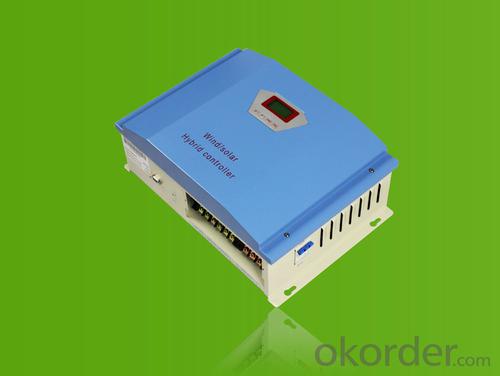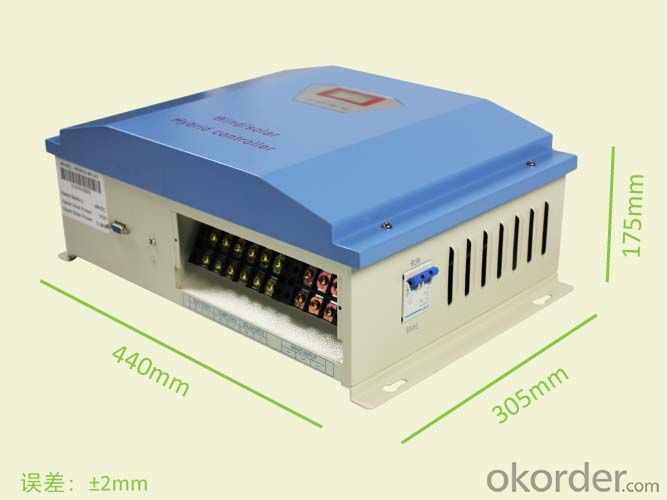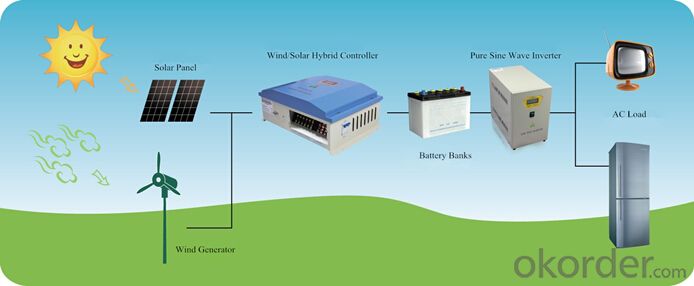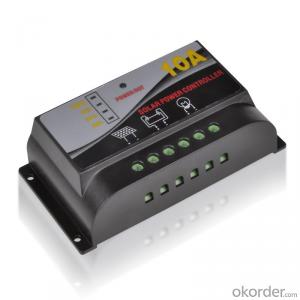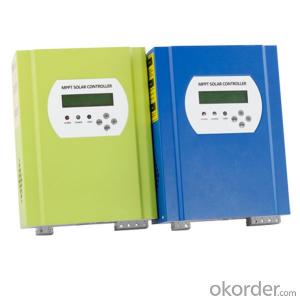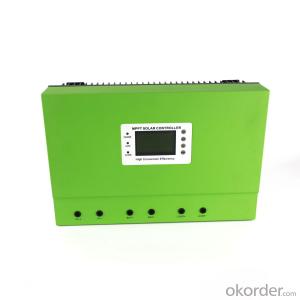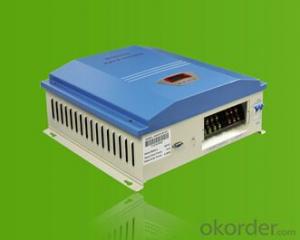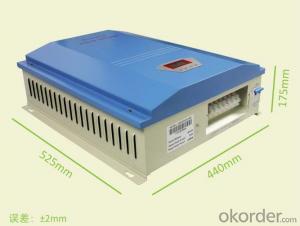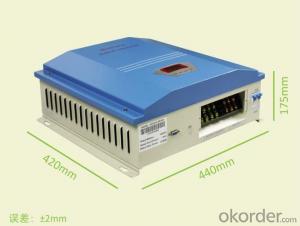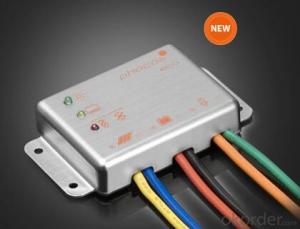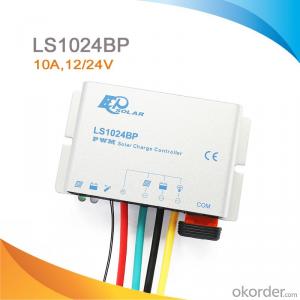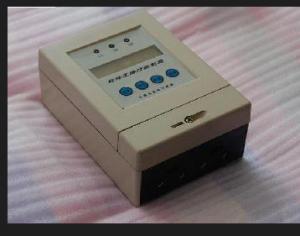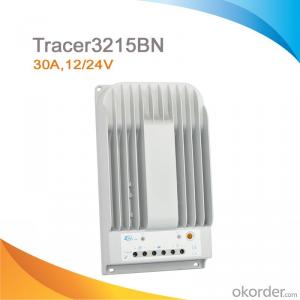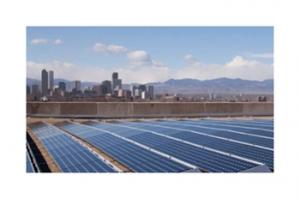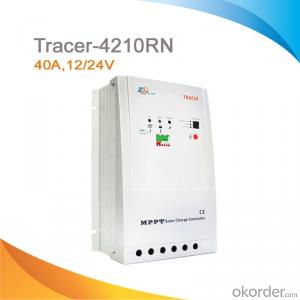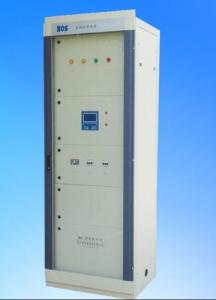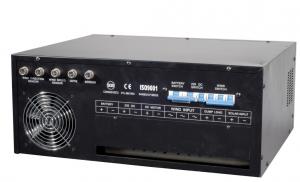Wind Solar Hybrid Controller 10KW PWM Stepless Unload Mode
- Loading Port:
- Shanghai
- Payment Terms:
- TT or LC
- Min Order Qty:
- 1 unit
- Supply Capability:
- 5000 unit/month
OKorder Service Pledge
OKorder Financial Service
You Might Also Like
I. PRODUCT INTRODUCTION
The wind/solar hybrid controller is control device which can control wind turbine and solar panel at the same time and transform wind and solar energy into electricity then store to the battery bank. Wind/solar hybrid controller is the most important part in offgrid system, whose performance has much effect on life expectancy and operational stability of the whole system, especially the battery expectancy. Or battery service life will be shortened by over-charge or over-discharge.
II. PERFORMANCE FEATURES
Superior military-grade components to ensure the product stability.² Perfect protection function, thus the system has higher reliabil ity.
Check and set all operation parameters as requirement from LCD display.
Voltage limiting and current-limiting charge mode ensures battery in the best charging status.
PWM stepless unload mode, which burn the excess power into dump load, making the battery charging in best status.
III. APPLICATION AREAS
Stand alone wind/solar hybrid power station; Stand alone domestic household wind/solar hybrid power system.
Mobile communication base stations, expressway and other non-residential regions.
Coastal islands, remote mountainous, border posts for regions shortage of or without electricity.
Government demonstration projects, landscape lighting project.
IV. 10KW TECHNICAL PARAMETERS
Product Model | WWS100-120 | WWS100-220 | WWS100-240 |
Rated battery voltage | 120 V | 220 V | 240V |
Rated wind turbine input power | 10 kW | 10 kW | 10 kW |
Maximum wind turbine input power | 15 kW | 15 kW | 15 kW |
Wind turbine brake current | 84 A | 46 A | 42 A |
Rated solar input power | 3 kW | 3 kW | 3 kW |
Floating charge voltage | 145 V | 266 V | 290 |
Dimension | Control Box:440×305×170 mm, Dumpload Box:520×430×675 mm | ||
Net Weight | Control Box:9 kg, Dumpload Box:45 kg | ||
Display Mode | LCD | ||
Cooling | Fan | ||
Protection Function | IP20(Indoor) | ||
Quiescent Current | ≤20 mA | ||
Protection Functions | Battery over charge; Battery over discharge; solar reverse charge protection; anti-reverse-connection protection; wind turbine over rotate speed protection; wind turbine over wind speed protection; wind turbine over voltage protection; wind turbine over current protection; manual brake protection; automatically brake protection; lightning protection. | ||
Ambient Temperature | -20~+55℃ | ||
Ambient Humidity | 0~93%, without condensing | ||
Working Altitude | ≤4000m | ||
In order to serve our customers better. Our company can adjust parameters configuration according to customer’s requirement. | |||
V. APPENDIX
Optional functions | ||
Ø Temperature compensation function | Ø Output dry-contact signal function | Ø SD card function |
Ø RS communication function | Ø Wind speed detection function | Ø Wind turbine rotate speed detection function |
Ø Wind turbine low voltage charge function | Ø Wind turbine MPPT charging function | Ø Wind turbine micro-current charge function |
Optional Accessories | ||
Ø Ethernet Module | Ø Ethernet Module | Ø Ethernet Module |
Ø RS485-USB Converter | Ø RS485-USB Converter | Ø RS485-USB Converter |
Friendly reminder: Customers, who will order the wind/solar hybrid controller, need to provide the following information
| ||
Ø Rated battery voltage | Ø Rated battery voltage | Ø Rated battery voltage |
Qualifications | ||
Ø Utility model patent of anti-strong-wind, stepless unload wind power controller | ||
Ø Utility model patent of wind power boost charge circuit. | ||
Ø Utility model patent of SD card document storage | ||
Ø New high-tech enterprise certificate | ||
Ø Utility model patent for integration of rectification and unload in wind power main circuit board. | ||
Ø European CE certification. Ø Software product register certification | ||
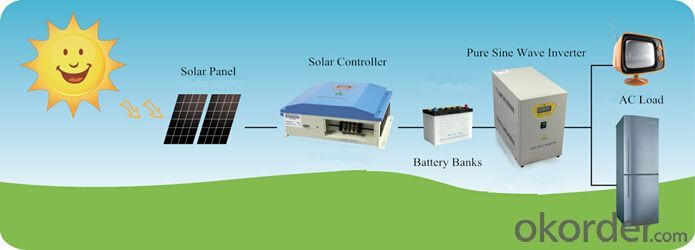
- Q: Can a solar controller be used with different types of solar panels (monocrystalline, polycrystalline, thin-film)?
- Yes, a solar controller can be used with different types of solar panels including monocrystalline, polycrystalline, and thin-film. The solar controller's main function is to regulate the charging process of the battery by monitoring the voltage and current from the solar panels. It is designed to work with various types of solar panels, making it compatible with different technologies and ensuring efficient charging regardless of the panel type.
- Q: Can a solar controller be used with a solar-powered agricultural system?
- Yes, a solar controller can be used with a solar-powered agricultural system. A solar controller helps regulate and optimize the charging and discharging of batteries in the system, ensuring efficient utilization of solar energy. It helps prevent overcharging and deep discharging, extending the lifespan of the batteries. Additionally, a solar controller can also provide monitoring and control features, allowing farmers to manage and adjust the system based on their agricultural needs.
- Q: What is the difference between a PWM and MPPT solar controller?
- A PWM (Pulse Width Modulation) solar controller regulates the voltage output from the solar panels by rapidly turning the panels on and off. It is a basic and cost-effective solution suitable for small-scale solar systems. On the other hand, an MPPT (Maximum Power Point Tracking) solar controller maximizes the power output from the solar panels by constantly adjusting the voltage and current to find the optimum operating point, known as the maximum power point. This advanced technology is more efficient and effective, particularly for larger solar systems or those with varying weather conditions.
- Q: Can a solar controller be used with solar panel arrays in series?
- Yes, a solar controller can be used with solar panel arrays in series. The solar controller regulates the charging process and ensures that the voltage and current from the series-connected solar panels are properly managed and optimized for charging the batteries or supplying power to the load.
- Q: What is the purpose of the battery overcharge protection feature on a solar controller?
- The battery overcharge protection feature on a solar controller serves to prevent damage to the batteries due to overcharging. When solar panels generate electricity from the sun, the excess energy is stored in batteries for future use. However, excessive charging beyond the batteries' capacity can result in overcharging, which poses several problems. Overcharging a battery can lead to overheating, causing degradation of its internal components and reducing its lifespan. It can also result in the release of hazardous gases, such as hydrogen, posing risks of explosions or fires. To mitigate these risks, solar controllers equipped with battery overcharge protection are designed to monitor the charging status of the batteries. Once the batteries reach their maximum capacity, the controller automatically detects this and interrupts the flow of electricity from the solar panels to the batteries, preventing further charging. This ensures that the batteries remain at an optimal charge level, promoting durability and safe operation. Moreover, the battery overcharge protection feature also optimizes the efficiency of the solar system. By preventing overcharging, the controller ensures that any excess energy generated by the solar panels is not wasted but can be used efficiently when needed. In conclusion, the battery overcharge protection feature on a solar controller aims to protect the batteries from potential damage caused by overcharging, prolong their lifespan, and enhance the overall efficiency of the solar system.
- Q: Solar street light controller only one button and digital display, would like to ask experts to learn how to design his time, the power is mainly want to know the specific mode of operation, please help explain the master
- Debug mode (6 ·): used for system debugging, when the optical signal is closed load, no light signal load, easy installation and commissioning check the correct installation of the system. Normally open mode (7 ·): The power load remains in the output state, which is suitable for 24 hours power supply.
- Q: How does a solar controller prevent damage from power spikes?
- A solar controller prevents damage from power spikes by regulating and stabilizing the flow of electricity from the solar panels to the battery. It acts as a barrier between the solar panels and the battery, ensuring that only the appropriate voltage and current are supplied to the battery, thus protecting it from potential damage caused by power spikes or surges.
- Q: How do PWM solar controllers work?
- PWM solar controllers work by regulating the voltage and current output from the solar panels to charge the battery efficiently. They achieve this by rapidly switching the panels' output on and off, essentially creating a pulsed signal. This pulsing technique, called Pulse Width Modulation (PWM), allows the controller to maintain a steady charging voltage while controlling the amount of current flowing into the battery. By adjusting the width of the pulses, the controller can regulate the charging process and prevent overcharging or damaging the battery.
- Q: What is the maximum number of load control timers supported by a solar controller?
- The maximum number of load control timers supported by a solar controller can vary depending on the specific model and brand. However, in general, solar controllers typically support a range of load control timers, with some models offering around 10 to 15 timers. It is important to refer to the product specifications or consult the manufacturer's documentation to determine the exact number of load control timers supported by a specific solar controller.
- Q: How does a solar controller handle fluctuations in ambient temperature?
- Temperature compensation features are integrated into a solar controller to effectively manage changes in ambient temperature. These features enable the solar controller to adapt the charging parameters according to the temperature conditions. In the event of an increase in ambient temperature, the solar controller takes precautions to prevent overcharging and potential battery damage by reducing the charging voltage. This is achieved through monitoring either the battery temperature or the ambient temperature directly. Conversely, if the ambient temperature drops, the solar controller compensates for the decreased battery capacity caused by cold temperatures by increasing the charging voltage. This guarantees that the batteries receive the appropriate charging voltage required to sustain their performance and lifespan. Moreover, advanced solar controllers can incorporate additional functionalities such as temperature sensors or probes. These sensors accurately measure the temperature of the battery or the surrounding environment, providing essential data for the solar controller to make the necessary adjustments. In conclusion, a solar controller effectively manages variations in ambient temperature by employing temperature compensation features, adjusting the charging parameters based on temperature conditions, and ensuring optimal charging voltage to uphold battery health and performance.
Send your message to us
Wind Solar Hybrid Controller 10KW PWM Stepless Unload Mode
- Loading Port:
- Shanghai
- Payment Terms:
- TT or LC
- Min Order Qty:
- 1 unit
- Supply Capability:
- 5000 unit/month
OKorder Service Pledge
OKorder Financial Service
Similar products
Hot products
Hot Searches
Related keywords

